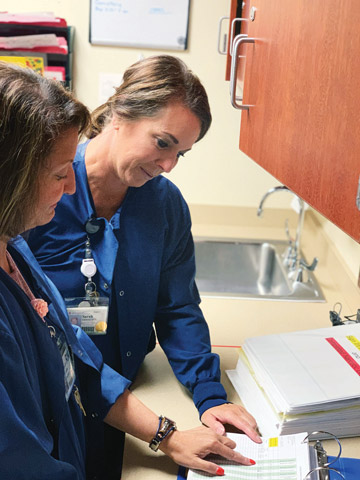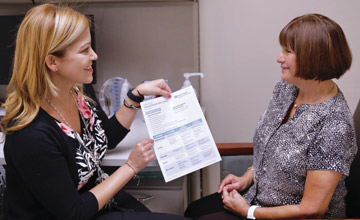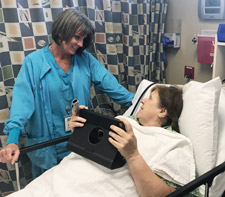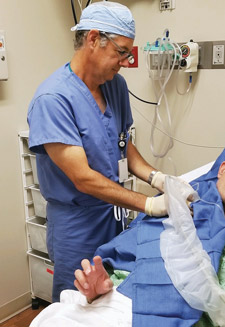April 25, 2024
Growing demand for anesthesia services at ASCs is being met with a dwindling supply of anesthesia providers....
This website uses cookies. to enhance your browsing experience, serve personalized ads or content, and analyze our traffic. By clicking “Accept & Close”, you consent to our use of cookies. Read our Privacy Policy to learn more.
By: Daniel Cook
Published: 9/11/2019
The OR team at Lakeside Surgery Center in Omaha, Neb., works hard to manage patients’ post-op pain with an eye toward the addiction epidemic. “Our nation is in the midst of an opioid crisis, and we’re doing our part to help fix it,” says Laura Rowe, MSN, RN, the center’s director of nursing. It’s that focus on making surgery a little more comfortable while protecting patients from opioid-related harm that earned Lakeside Surgery Center the OR Excellence Award in Pain Control.
The center’s home state of Nebraska was one of the first in the nation to pass a law requiring physicians who prescribe opioids to educate patients about the potential for and the dangers of addiction and overdose. The law also limits all opioid prescriptions to a 7-day supply. To comply with the new legislation, Lakeside created a form that outlines the risks of physiological and psychological dependence on opioids, outlines non-opioid treatment options and details how to safely dispose of unused pills. Patients who’ll receive opioids for post-op pain control must sign the sheet before undergoing surgery.
If surgeons believe patients will require more than a 7-day supply of opioids, they must fill out and sign a separate form acknowledging that they educated patients about the risks of taking an extended course of opioids and list on the form the medical conditions necessitating more than a week’s supply of the painkillers. The form remains with patients’ charts on the day of surgery and is added to their medical records.
“We’ve realized that our team plays a crucial role in educating patients about alternative pain control options,” says Ms. Rowe. “We explain that they don’t have to take opioids to find relief from post-op pain. There are other effective methods.”
Lakeside’s anesthesia providers, surgeons and nursing staff stay current on pain management research and constantly work to incorporate the latest developments into their protocols and practices. For example, they’re reevaluating the benefits of using IV NSAIDs to reduce tissue inflammation based on what the center’s anesthesiologist medical director heard at a national conference. Additionally, the team recently took steps to enhance its pain management protocols.
Now, in pre-op, patients receive:
During surgery, they receive:
In post-op, they receive:

The medical director might add long-lasting Exparel (liposomal bupivacaine) injections to the multimodal protocol in preparation of launching a total joints program.
Lakeside’s nurses don’t write scripts for post-op pain meds, but, like nurses everywhere, they take their role as patient advocates very seriously.
“Surgeons don’t always have the time to review our protocols and discuss the importance of managing pain with a limited amount of opioids,” says Ms. Rowe. “Our nurses fill that gap, and patients value the education they receive from them.”
Staff make copies of discharge prescriptions so nurses have a record of the medications patients should be taking when they make follow-up phone calls. “We always ask about their pain levels to find out if the medications we sent them home with are working effectively,” says Ms. Rowe.
Communications with patients about the center’s pain management protocols also focus on the nerve blocks anesthesia providers place, including:
All patients are at risk of experiencing higher than acceptable post-op pain. Overprescribing opioids is a quick and easy way to ensure they remain comfortable and satisfied with the care they receive, but sending them home with too many pills increases the risk of abuse and addiction.
That’s why educating patients about the effectiveness of alternative therapies is so essential, according to Ms. Rowe, who says you shouldn’t overlook basic recovery protocols such as rest, ice and elevation. “We have custom ice packs designed for placing around hips, knees and wrists that patients really love,” says Ms. Rowe. “We also send them home with an extra pack, so they always have one in the freezer, ready to go.”
That attention to detail shows how focused the team at Lakeside Surgery Center is on ensuring patients recover from surgery in as little pain as possible. “We tell patients to trust our opioid-sparring treatments and see how they respond,” she adds. “They know we’ll always do whatever it takes to make them comfortable.” OSM

Efforts are being made in surgical facilities across the country to control post-op pain with creative and effective solutions. Here are a few worthy of recognition.


Growing demand for anesthesia services at ASCs is being met with a dwindling supply of anesthesia providers....
Improvements in both workflow and staff attitudes are part of a leader’s responsibilities, but your interventions in these areas don’t need to be major to make...
The ASC market continues its rapid growth. In 2023, roughly 116 new ASCs opened in the U.S., many of which were orthopedic-specific in nature....